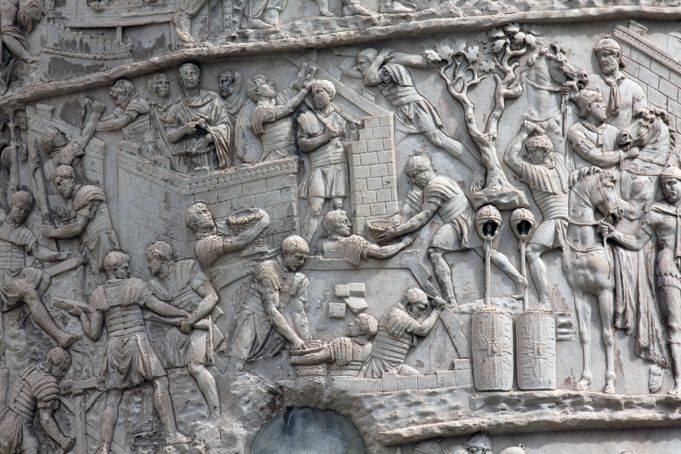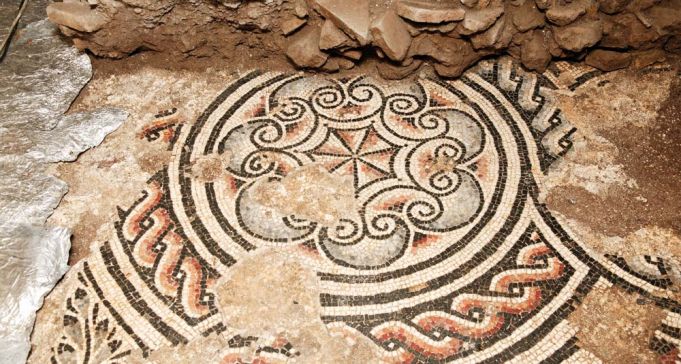Virtual reality transforms the graphic war scenes on Trajan's Column in Rome.
Rome’s most impressive novelties tend to be ancient, emerging after millennia from below ground. Viewable after a descent of two or three storeys below Palazzo Valentini on Via IV Novembre, one gazes, courtesy of a vertiginous glass floor, down on what must be a contender for the world’s largest column.
There it lies on its side, a single stretch of grey granite, two metres in diameter. It is the dramatic outcome of excavations begun in 2010 and pending further investigation, it is posited as being one of the supports of the temple to Trajan and his wife Plotina, until now vanished in time. Nearby and deeper still – this tour is not for those with a fear of heights – one can peer down an illuminated core into what was the column’s base, while behind that plummets a mediaeval well.
Adding to the fourth-century AD Domus Romanae in Palazzo Valentini, the underground tour also uses virtual technology to recreate the images on the better-known Trajan’s Column in Trajan's Forum. On the screen unfolds, scene by chilling scene, the newsreel of Trajan’s invasions of Dacia (present-day Romania), the narrative probably following Trajan’s own commentaries, a lost equivalent of Caesar’s Gallic Wars. Small wonder that the sculptor of the column – possibly Apollodorus from Damascus, the architect of much of Trajan’s Forum – became an inspiration to those of the 14th-century Renaissance.

No mere propagandist, the sculptor manages to depict war in all its fierceness and cruelty, and now virtual technology has converted the original panels into even more graphic 3-D. The Roman soldiery appears, as surely it did to the Dacian enemy, extremely well drilled yet often mercilessly mechanical. Less well armoured and at a technological disadvantage, the Dacians emerge as both more human and vulnerable.
In one scene a fallen Dacian pleads for his life; in another, defeated locals seek shelter under the shields of dead comrades. Elsewhere Roman soldiers dangle decapitated heads from their teeth. More shocking still is seeing naked Roman soldiers with hands tied behind their backs and being tortured by Dacian women in a “clip” modern newsreels would censor.
In another scene the besieged Dacians are seen taking poison rather than fall into Roman hands, while the penultimate panel has Decebulus, the proud Dacian leader, slitting his throat beneath a tree. War, however, is treated not just in terms of blood, but also of logistics. The lower panels show the Romans setting up base camp. Communication torches flare from pre-built towers, relaying dispatches back to Rome, while a river-god emerges from the Danube to wish – rather treacherously one might say from a Dacian viewpoint – the invaders well. We see a man falling off a wall, Trajan quick to take this as a favourable omen for the fall of the whole Dacian people.
There are soldiers cutting trees, there is a bridge of ships. Then higher up the column, preluding the second campaign, there is a bridge of stone. As important as courting public opinion in present-day wars, both ancient campaigns depict Trajan making sacrifices of wine and animals to the gods: Jove responds higher up the column by launching thunderbolts. A further reminder that, as Lucretius complained, Mars not Venus was the deity of Rome, at the siege of the curvy-walled Dacian capital Sarmizegusta Roman military hardware is only too evident, along with the Dacians’ subsequent scorched earth policy.
Originally all the scenes would have been visible from terraces positioned along the two adjacent libraries on one side of Trajan’s Forum and the Ulpian basilica on the other, the marble column being an innovation that was longer-lasting than the ephemeral painted panels of victories previously carried in Roman triumphs. Like the rest of Trajan’s Forum, both libraries and basilica with their viewing terraces have been largely carted away by Goths, Huns or Roman nobles.

Until recently it was impossible to follow the whole narrative up close. For a completely cinematic view one would have to have been 40 metres tall, or the height of the hill that was levelled to make room for Trajan’s Column in the forum. In Renaissance times one Iacopo Ripanda partly got round the problem of viewing difficulties by lowering himself down the column in a basket lassoed to the top, then making drawings as he descended.
From the end of the Roman empire hermits who had a penchant for heights frequented the column. In fact, in the 1300s a chapel was built at the bottom of the column. The verger, also a hermit, placed a bell at the top. From then on both chapel and column enjoyed papal protection. In 1587 Sixtus V, after a rite of exorcism against any remaining pagan demons, placed a statue of St Peter on the summit. The column became something of a money-spinner, pilgrims paying to climb the 185 steps of the internal staircase for one of Rome’s top views.
Trajan’s immortalisation device had taken a turn that neither he nor Plotina, his wife and campaign companion – their ashes mingled in a golden urn at the base of the column – could have foreseen. All of a sudden Trajan – deified along with Plotina by Hadrian, his successor and adoptive son – was seriously downsized. Yet now after a five-century gap his feats are again clearly on show, more graphic than ever. A section of a large column now visible under the present day Palazzo Valentini may be part of the long-lost Temple of Trajan.
By Martin Bennett
Published originally in the May 2012 edition of Wanted in Rome magazine.
General Info
View on Map
Trajan's Column comes to life in Rome
Le Domus Romane di Palazzo Valentini, Foro Traiano, Rome, Metropolitan City of Rome, Italy


















